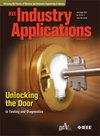Pulsating Torque Suppression of Flux Reversal Machines Based on Specific Harmonic Contributions of Rotor Permeance and PM MMF
IF 4.5
2区 工程技术
Q2 ENGINEERING, ELECTRICAL & ELECTRONIC
引用次数: 0
Abstract
Flux reversal machines (FRMs) exhibit high torque density, but also significant pulsating torque, including cogging torque and torque ripple. Traditional methods fail to separate the harmonics that affect torque density and pulsating torque, leading to a degradation of torque density when reducing pulsating torque. Therefore, to maintain torque density and simultaneously reduce pulsating torque, this paper proposes a novel FRM configuration incorporating shape designs for the rotor and permanent magnets (PMs). First, the key generation mechanisms of cogging torque, average torque, and torque ripple are thoroughly examined, with analytical expressions derived to classify the torque contributions of all air-gap magnetic field harmonics into negative-effect and positive-effect components. Further, the rotor and PM shapes are designed to enhance the positive-effect components and reduce the negative-effect ones of the air-gap permeance and magnetomotive force (MMF). The impacts of geometric parameters are evaluated by using a sensitivity-based hierarchical optimization approach. Then, the proposed FRM is comprehensively compared with a conventional FRM in terms of back-electromotive force (EMF), cogging torque, average torque, torque ripple, efficiency, etc. The results indicate that the proposed machine configuration achieves reductions in cogging torque and torque ripple by 90% and 86.8%, respectively, while maintaining consistent average torque. Finally, a 12-slot/10-pole FRM prototype was built and tested to validate the effectiveness of the proposed machine topology.基于转子磁导率和PM MMF比谐波贡献的磁通反转电机脉动转矩抑制
磁通反转电机(FRMs)具有较高的转矩密度,但也有显著的脉动转矩,包括齿槽转矩和转矩脉动。传统方法无法分离影响转矩密度和脉动转矩的谐波,导致在减小脉动转矩时转矩密度下降。因此,为了保持转矩密度并同时减小脉动转矩,本文提出了一种结合转子和永磁体(pm)形状设计的新型FRM结构。首先,深入研究了齿槽转矩、平均转矩和转矩脉动的关键产生机理,并推导出解析表达式,将所有气隙磁场谐波的转矩贡献分为负效应分量和正效应分量。进一步设计了转子和永磁材料的形状,以增强气隙磁导率和磁动势(MMF)的正影响分量,减少负影响分量。采用基于灵敏度的分层优化方法对几何参数的影响进行了评价。然后,从反电动势(EMF)、齿槽转矩、平均转矩、转矩脉动、效率等方面与传统的FRM进行了综合比较。结果表明,在保持平均转矩不变的情况下,该结构的齿槽转矩和转矩脉动分别降低了90%和86.8%。最后,建立了一个12槽/10极FRM原型并进行了测试,以验证所提出的机器拓扑结构的有效性。
本文章由计算机程序翻译,如有差异,请以英文原文为准。
求助全文
约1分钟内获得全文
求助全文
来源期刊

IEEE Transactions on Industry Applications
工程技术-工程:电子与电气
CiteScore
9.90
自引率
9.10%
发文量
747
审稿时长
3.3 months
期刊介绍:
The scope of the IEEE Transactions on Industry Applications includes all scope items of the IEEE Industry Applications Society, that is, the advancement of the theory and practice of electrical and electronic engineering in the development, design, manufacture, and application of electrical systems, apparatus, devices, and controls to the processes and equipment of industry and commerce; the promotion of safe, reliable, and economic installations; industry leadership in energy conservation and environmental, health, and safety issues; the creation of voluntary engineering standards and recommended practices; and the professional development of its membership.
 求助内容:
求助内容: 应助结果提醒方式:
应助结果提醒方式:


